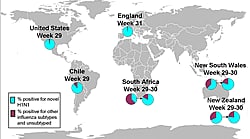Centers for Disease Control and Prevention (CDC)
"Updated federal guidelines offer state and local public health and school officials a range of options for responding to 2009 H1N1 influenza in schools, depending on how severe the flu may be in their communities. The guidance says officials should balance the risk of flu in their communities with the disruption that school dismissals will cause in education and the wider community.
- Guidance for State and Local Health Officials and School Administrators for School Responses to Flu during 2009-2010 School Year
- Technical Report for State and Local Health Officials and School Administrators on CDC Guidance for School Responses to Flu during 2009-2010 School Year
- Preparing for Flu: A Communication Toolkit for Schools (K-12)
- Webcast: August 7 Press Briefing by HHS/CDC, Department of Education, and Department of Homeland Security
Recommendations for the Amount of Time Persons with Flu-Like Illness Should be Away from Others
CDC recommends that people with influenza-like illness remain at home until at least 24 hours after they are free of fever (100° F [37.8°C]), or signs of a fever without the use of fever-reducing medications. This is a change from the previous recommendation that ill persons stay home for 7 days after illness onset or until 24 hours after the resolution of symptoms, whichever was longer. The new recommendation applies to camps, schools, businesses, mass gatherings, and other community settings where the majority of people are not at increased risk for influenza complications.
International Situation Update
This situation report provides an update to the international situation as of August 4, 2009. World Health Organization (WHO) regions have reported 162,380 laboratory-confirmed cases of novel influenza A (H1N1) and 1,154 deaths. The laboratory-confirmed cases represent an underestimation of total cases in the world as many countries have shifted to strategies of clinical confirmation and prioritization of laboratory testing for only persons with severe illness and/or high risk conditions. The novel influenza A (H1N1) virus is the dominant influenza virus in circulation in the United States, England, South Africa, New Zealand, Australia, Chile, Argentina and Brazil. South Africa has had a notable increase in the proportion of influenza that is novel influenza A (H1N1), and now it represents the majority of influenza in the country. Many seasonal influenza viruses from these countries have not been subtyped. Of those that have been subtyped in Australia, South Africa, and Argentina, the most common seasonal influenza virus is influenza A (H3N2).
For more information about the U.S. situation, see the CDC H1N1 Flu International Situation Update Page.
Recent Updates of Interest- Weekly FluView Map and Surveillance Report for Week Ending August 1, 2009
During week 30 (July 26-August 1, 2009), influenza activity decreased in the United States, however, there were still higher levels of influenza-like illness than is normal for this time of year. - Preparing for the Flu: A Communication Toolkit for Schools (Grades K-12)
The purpose of "Preparing for the Flu: A Communication Toolkit for Schools" is to provide basic information and communication resources to help school administrators implement recommendations from CDC's Guidance for State and Local Public Health Officials and School Administrators for School (K-12) Responses to Influenza during the 2009-2010 School Year. - Technical Report for State and Local Public Health Officials and School Administrators on CDC Guidance for School (K-12) Responses to Influenza during the 2009-2010 School Year
This Technical Report includes detailed information on the reasons for the strategies presented in the CDC Guidance for School (K-12) Responses to Influenza During the 2009-2010 School Year and suggestions on how to use them. The guidance is designed to decrease exposure to regular seasonal flu and 2009 H1N1 flu while limiting the disruption of day-to-day activities and the vital learning that goes on in schools. CDC will continue to monitor the situation and update the current guidance as more information is obtained on 2009 H1N1. - CDC Guidance for State and Local Public Health Officials and School Administrators for School (K-12) Responses to Influenza during the 2009-2010 School Year
This document provides guidance to help decrease the spread of flu among students and school staff during the 2009-2010 school year. This document expands upon earlier school guidance documents by providing a menu of tools that school and health officials can choose from based on conditions in their area. It recommends actions to take this school year and suggests strategies to use if CDC finds that the flu starts causing more severe disease. The guidance also provides a checklist for making decisions at the local level. - UPDATE: Novel H1N1 Flu and You
Revised to reflect CDC's new recommendations for the amount of time persons with influenza-like illness should be away from others. CDC recommends that people with influenza-like illness remain at home until at least 24 hours after they are free of fever (100 degrees F or 37.8 degrees C), or signs of a fever without the use of fever-reducing medications. This is a change from the previous recommendation that ill persons stay home for 7 days after illness onset or until 24 hours after the resolution of symptoms, whichever was longer. - CDC Recommendations for the Amount of Time Persons with Influenza-Like Illness Should be Away from Others
CDC recommends that people with influenza-like illness remain at home until at least 24 hours after they are free of fever (100 degrees F or 37.8 degrees C), or signs of a fever without the use of fever-reducing medications. This is a change from the previous recommendation that ill persons stay home for 7 days after illness onset or until 24 hours after the resolution of symptoms, whichever was longer. The new recommendation applies to camps, schools, businesses, mass gatherings, and other community settings where the majority of people are not at increased risk for influenza complications. This guidance does not apply to health care settings where the exclusion period should be continued for 7 days from symptom onset or until the resolution of symptoms, whichever is longer. - School Dismissal Monitoring System
CDC and the U.S. Department of Education, in collaboration with state and local health and education agencies and national non-governmental organizations, have implemented a school dismissal monitoring system for the 2009-2010 school year. This monitoring system generates real-time, national summary data daily on the number of school dismissals and the number of impacted students and teachers. - Planning and Preparing for Novel H1N1 Vaccination
Information for professionals on planning and preparing for H1N1 vaccination.
Additional Updates on the CDC H1N1 Flu Website
To learn about other recent updates made to the CDC H1N1 Flu Website, please check the "What's New" page on the CDC H1N1 Flu website.
  | | |












0 espirros:
Enviar um comentário